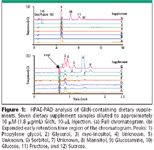Rapid and Rugged Determination of Glucosamine in Dietary Supplements Using HPAE-PAD
Glucosamine (GlcN) is a major structural component in the biosynthesis of glycosaminoglycans, compounds involved in normal joint function. Use of GlcN as a dietary supplement in the management of osteoarthritis has attracted considerable attention; it is one of the five nonvitamin, nonmineral supplements most frequently used by US adults (1). The US FDA currently regulates dietary supplements to ensure that they are produced under cGMP (2).
Glucosamine (GlcN) is a major structural component in the biosynthesis of glycosaminoglycans, compounds involved in normal joint function. Use of GlcN as a dietary supplement in the management of osteoarthritis has attracted considerable attention; it is one of the five nonvitamin, nonmineral supplements most frequently used by US adults (1). The US FDA currently regulates dietary supplements to ensure that they are produced under cGMP (2).
High-performance anion-exchange (HPAE) chromatography rapidly and efficiently separates carbohydrates (3, 4). HPAE, when coupled with pulsed amperometric detection (PAD), can be used to determine carbohydrates such as GlcN directly without chemical derivatization.
This article reports a rapid, rugged HPAE-PAD method for determining GlcN in dietary supplement tablets, gelatin capsules, and fortified liquids. The method is suited for high sample throughput while having the selectivity to resolve and detect many other mono- and disaccharides that may be present in the supplement. Electrolytic eluent generation assures eluent purity and consistency while reducing operator labor.
Experimental
Analyses were performed using a Dionex ICS-3000 equipped with pump, Eluent Generator, CR-ATC, electrochemical detector, AS Autosampler, and Chromeleon® Chromatography Workstation. Separations were performed using a CarboPac® PA20 column (Dionex P/N 060142) and 20 mM KOH eluent. For detailed experimental conditions, see Dionex Application Note 197 (5).
Results and Discussion
Figure 1 shows chromatograms for seven GlcN dietary supplements diluted with DI water to a target concentration of 10 μM (1.8 μg/mL) GlcN free base. Mono- and disaccharides and sugar alcohols, present in significant amounts in some of the supplements, were sufficiently separated from GlcN and did not interfere with its determination. Although we expected that N-acetylglucosamine might be present in some of the dietary supplements, it was not found. HPAE-PAD can be used to determine other carbohydrates or glycols present in dietary supplements, such as glycerol, glucose, fructose, sucrose, myo-inositol, sorbitol, and mannitol (Figure 1B).

Figure 1
While the full linear range in this study covered more than three orders of magnitude from 0.30–340 μM (0.06–61 μg/mL) for a 10 μL injection, our routine GlcN determination used a dilution scheme that targeted a 10 μM (1.8 μg/mL) GlcN concentration and a calibration range of 18–360% of target. At our target concentration, spike recovery was 99%. GlcN retention time and peak area decreased only 1.5% over five days of consecutive injections (N=718) without any column washing. The determined amounts of GlcN for the seven supplement samples ranged from 110%–152% of the GlcN label value.
Conclusions
HPAE-PAD with eluent generation provides a direct, rapid, and simple method for determining GlcN in dietary supplements. Sample preparation consists of simply dissolving samples in DI water, removing particulates by centrifugation, and injecting the diluted sample. The high capacity of the CarboPac PA20 and the use of eluent generation enable the isocratic analysis of over 100 samples per day for five days with the analyst required only to add water and samples to the system.
References
(1) Kennedy, J. "Herb and Supplement Use in the US Adult Population." Clin. Thera. 2005, 27, 1845–1858.
(2) U.S. Department of Health and Human Services, Food and Drug Administration, "21 CFR Part 111 Current Good Manufacturing Practice in Manufacturing, Packaging, Labeling, or Holding Operations for Dietary Supplements;" Final Rule. Fed. Regist. 2007, 72, 34751–34958. http://www.fda.gov/OHRMS/DOCKETS/98fr/07-3039.pdf.
(3) Dionex Corporation. "Glycoprotein Monosaccharide Analysis Using High-Performance Anion-Exchange Chromatography with Pulsed Amperometric Detection (HPAE-PAD) and Eluent Generation;" Technical Note 40, LPN 1632. Sunnyvale, CA, 2004.
(4) Dionex Corporation. "Analysis of Carbohydrates by High-Performance Anion-Exchange Chromatography with Pulsed Amperometric Detection (HPAE-PAD);" Technical Note 20, LPN 032857-04. Sunnyvale, CA, 2000.
(5) Dionex Corporation. "Determination of Glucosamine in Dietary Supplements Using HPAE-PAD;" Application Note 197, LPN 2001. Sunnyvale, CA, 2008.
Dionex Corporation
1228 Titan Way, P.O. Box 3603, Sunnyvale, CA 94088-3603
tel. (408) 737-0700, fax (408) 730-9403

Automated Sample Preparation (ISO 20122) for MOSH/MOAH in Seasoning Oils
May 6th 2025This work presents an Automated Sample Preparation procedure for MOSH/MOAH analysis of Seasoning Oils. We compare results from a manual epoxidation procedure compliant with DIN 16995 with results based on fully automated sample preparation (epoxidation and saponification) compliant with ISO 20122. In both cases, online clean-up via activated aluminum oxide (AlOx) are used to remove interfering n-alkanes from the MOSH fraction during the HPLC run. Automated data evaluation using a dedicated software (GERSTEL ChroMOH) is presented.
Free Poster: NDSRI Risk Assessment and Trace-Level Analysis of N-Nitrosamines
April 25th 2025With increasing concern over genotoxic nitrosamine contaminants, regulatory bodies like the FDA and EMA have introduced strict guidelines following several high-profile drug recalls. This poster showcases a case study where LGC and Waters developed a UPLC/MS/MS method for quantifying trace levels of N-nitroso-sertraline in sertraline using Waters mass spectrometry and LGC reference standards.
New TRC Facility Accelerates Innovation and Delivery
April 25th 2025We’ve expanded our capabilities with a state-of-the-art, 200,000 sq ft TRC facility in Toronto, completed in 2024 and staffed by over 100 PhD- and MSc-level scientists. This investment enables the development of more innovative compounds, a broader catalogue and custom offering, and streamlined operations for faster delivery. • Our extensive range of over 100,000 high-quality research chemicals—including APIs, metabolites, and impurities in both native and stable isotope-labelled forms—provides essential tools for uncovering molecular disease mechanisms and exploring new opportunities for therapeutic intervention.

.png&w=3840&q=75)

.png&w=3840&q=75)



.png&w=3840&q=75)



.png&w=3840&q=75)













